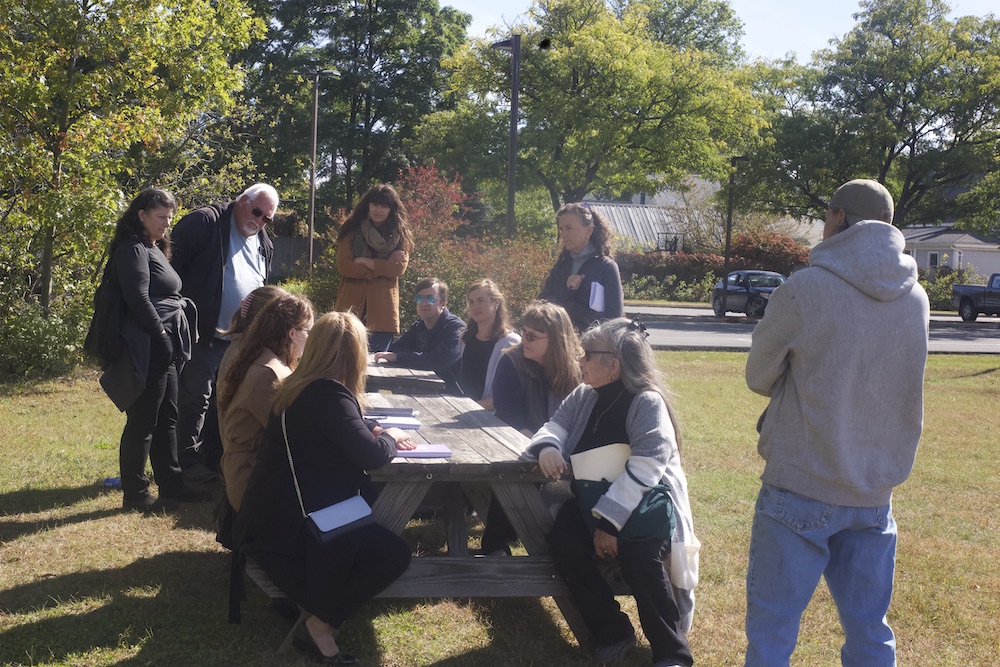by Elise Greaves, New England Resident Owned Communities
It was a beautiful fall day, and board members from three Vermont Resident Owned Communities made the most of it. Not by hiking or fishing or raking leaves like you might expect for Vermonters on a fall afternoon. Instead, these ROC leaders used the day as an opportunity to show off their communities to federal housing policy makers. Members from three ROCs — St. George Community Cooperative in St. George, Westbury Cooperative in Colchester, and North Avenue Cooperative in Burlington – toured the North Avenue Cooperative, making the appeal to DC decision-makers about the deep need for infrastructure and public health updates in ROCs, and the importance of public investment in these communities.

The tour was designed to show how PRICE, a proposed federal grant program for ROCs and non-profit communities, would make a huge difference in sustaining this deeply affordable housing source, especially during the ongoing housing crisis across the nation. The Senate is due to vote on including the program in this year’s Transportation & Housing funding bill later this fall.
ROCs all across the country need major water, septic, electrical, and other utility work to ensure that residents are safe and healthy and can afford to stay in their homes long-term. Addressing the needs of the 16 ROCs in Vermont alone would cost 25MM dollars. While 5MM has been committed from various sources so far, there is a 20MM gap for current known needs in all of the communities. The proposed federal PRICE program – which allocates 500MM specifically for resident-owned and non-profit communities – would be key to filling such gaps, both in Vermont and in states throughout the Northeast.
The visitors from D.C. heard about the challenges residents face trying to finance improvement projects. Often these co-ops inherit crumbling infrastructure from previous, private owners who deferred important work. “We run on a shoestring budget to keep rents down for the many residents on fixed incomes,” noted Stephen Hamlin, North Avenue’s board president. “We explained the funding avenues we have worked for, but they fall way short of the high costs of the construction we need. I hope we were able to show how not-for-profit parks are a very good source of affordable housing.”
Three stops on the tour of North Avenue Co-op stood out: a visit to a new, net-zero energy efficient home; a site that was prepped for another new, permanently affordable home to come in, and the location where the community’s aging water lines recently broke down. The leak alone cost over $11,000 just to plug. It can take many years for ROCs to put together enough in grants and low-interest loans to bring the park systems current; in the meantime they have to keep spending precious dollars to patch systems that are long past their useful lives.
While Vermont is ahead of curve in making resources available for co-ops and other non-profit parks to update their systems, it is still not enough to meet the 20MM funding gap for ROCs alone. Mobile-home communities have been left out of many federal programs, while others such as the Community Development Block Grant (CDBG) require a municipal sponsor, which can pose a capacity challenge for small towns in rural states. Likewise, many manufactured housing communities continue to fight existing cultural stigma against them as they compete for funding with other organizations and in-need populations.
While they face many challenges, ROC board members also shared stories of success and their determination to meet the needs of their community. North Avenue has brought in 12 new homes since it bought the park in 2015. Another board North Ave board member told a story about how he moved in during the COVID pandemic. He explained that as rents in Burlington were rising sharply, he looked into homeownership as an alternative and discovered the option to buy his home at NAC in partnership with Habitat for Humanity. Even with a mortgage, the affordable lot rent at NAC keeps his housing costs lower than when he was sharing a two-bedroom apartment! By contrast, Lisa Hodgkins of St. George has lived in her community for over thirty years. “I bought my home when we first got married as affordable housing, and my commute is just minutes,” she shared. “As I get closer to retirement age I am hoping to remain where I am, if our co-op can find the funding necessary to support the infrastructure.”
When asked how she felt the tour went, Hodgkins reflected, “I was struck by how important it is for us to stand up and put faces to the issue of affordable housing. I felt that our voices and concerns were not only heard, but there is now a real understanding of the needs.”
The tour was a testament to the care and dedication these all-volunteer boards bring to operating their communities and looking after their neighbors, and it was clear that policy makers heard and saw this commitment. Vermont leaders hope hope other ROCs will join them in calling on Congress to invest in the most affordable form of homeownership in the country.

Thank you Vermont ROC leaders and CDI staff for helping educate policy makers on the needs and opportunities in preserving and improving mobile home communities. They’ve been overlooked for too long! Thank you for your leadership. ROC on!